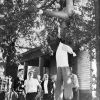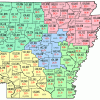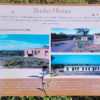calsfoundation@cals.org
White Flight
“White flight”—the departure of white residents from racially mixed cities to heavily white suburban enclaves in reaction to court-ordered school desegregation—occurred in several urban communities in Arkansas. Related changes occurred in other communities in the state during the same period, especially in the Arkansas Delta. There, many white families moved children into private, all-white “academies” as desegregation was implemented. In addition, many families—both white and black—chose to depart such communities entirely, although it seems clear that those demographic changes were caused more by a sense of economic hopelessness than school politics. While towns such as Pine Bluff (Jefferson County) evidenced “white flight” in the aftermath of court orders in the latter decades of the twentieth century, it was in the state’s largest metropolitan area, Little Rock (Pulaski County), where such white flight became most pronounced, particularly in the 1980s. Significant social and political ramifications accompanied this demographic change.
In the years after token school desegregation began in most of the South, metropolitan areas tended to follow one of two paths: the Atlanta, Georgia, model or the Charlotte, North Carolina, model. Between 1960 and the mid-1970s, the cities that went the direction of Atlanta (Memphis, Tennessee, and New Orleans, Louisiana, clearly fall in this category) showed aggressive white flight, with the rising suburbs becoming emphatic about their autonomy; the majority African-American cities that were left behind were poorer but became enclaves of black empowerment. In cities that followed the Charlotte model (such as Nashville, Tennessee, and Jacksonville, Florida), regionalism reigned; here, populations were stable, the boundaries of the city grew with the population, and governmental entities merged. African Americans were often frustrated by their lack of political power, as Charlotte-model cities kept whites in political power through at-large elections, and neighborhoods tended to segregate by class and race. In the Charlotte model, however, whites and blacks were forced to work together within school districts and cities. Indeed, some of these school districts became some of the most thoroughly integrated in the nation in the 1970s and 1980s.
An analysis of the demographic patterns in Arkansas’s largest metropolitan area shows that neither model adequately explains the Little Rock experience. Little Rock started down a path that shows key characteristics of the Charlotte model, including the denial of black empowerment through the use of at-large elections. Key federal court activities related to desegregation in the mid-1980s, however, spurred a watered-down version of the metropolitan divergence seen in Memphis and Atlanta. At the same time, Little Rock itself became a city of emphatic racial and class separation within its growing city boundaries. The key force in that separation was the development of Interstate 630 through the heart of the city, completed in 1985. Thus, Little Rock ended up with some of the most problematic aspects of each of the two models.
Compared to other Southern cities, Little Rock at the time of the desegregation of Central High School in 1957 had a small physical footprint with a densely packed population at its core. Even more important, most of the neighborhoods in the city were racially mixed. The southeastern part of the city was largely African American, and the northwest corridor of the city of the late 1950s was wealthier than the remainder of the city and totally white, but most remaining residential areas of Little Rock included both white and black residents, most of them working class. As a result, while key elements of Jim Crow certainly remained in place, Little Rock’s white and black populations were not entirely separated from one another in their daily lives.
Relatively little demographic change occurred in the Little Rock metropolitan area during the first decade after the desegregation of Central High. The exception was the growth of the city’s footprint to the west. While some housing development continued in the core of the city, most occurred on the city’s western edge, where more affluent residents were able to move to larger homes on larger lots; these residents thus gained some of the perceived benefits of suburbanization without having to uproot to the suburbs. Importantly, however, during the decade after Central High’s desegregation, white residents mostly stayed within the city boundaries and in the public schools. As enfranchised African Americans began to participate more fully in politics, some biracial politics developed.
Court decisions in the late 1960s and early 1970s began to shake this relative stability. In 1968, the U.S. Supreme Court declared unconstitutional the “freedom of choice” plans that perpetuated purely token desegregation throughout the South, including in Little Rock. In 1971, the Court’s decision in Swann v. Charlotte-Mecklenberg Board of Education deemed appropriate the use of busing to remedy segregation, and the Little Rock School District fully implemented a busing plan by the fall of 1973. These decisions, particularly Swann, promoted private-school development in Little Rock proper, and school attendance in Little Rock suburban growth areas, especially in Saline County, also became more prevalent in the 1970s.
These changes nevertheless were surprisingly modest, as more than ninety percent of the students in Pulaski County stayed in public schools through the early 1980s, and population growth in the city continued. The key reason for this apparent stability: While the city boundaries of Little Rock had continued to grow to the west as new development occurred, the boundaries of the Little Rock School District had stopped growing in 1968 when the Court ended “freedom of choice.” Thus, residents on the western edge of Little Rock maintained access to city services, but their children attended school in the overwhelmingly white Pulaski County Special School District. By the early 1980s, about forty percent of the city’s land mass was in the county district. These decisions promoted sprawl, albeit mostly still within the city, along with its social and environmental ramifications. Along with the development of a six-lane interstate highway through the heart of the city, these decisions also helped gradually separate the residents of Little Rock into different and more segregated enclaves, taking Little Rock off the path taken by cities like Charlotte.
Hints of suburbanization and private-school development, shown after the implementation of busing, went into overdrive after another jolt from the federal courts. In 1984, United States district judge Henry Woods ordered the merger of all three Pulaski County school districts as the only effective attack on segregation in Little Rock’s schools. While much of that decision would be overturned by the Eighth Circuit Court of Appeals a year later, the issue of busing returned with intensity, with flames being fanned by political leaders such as Congressman Tommy Robinson in his successful 1984 election to the U.S. House of Representatives and by suburban realtors advertising “Cabot Schools” or “Bryant Schools,” using the fears related to the future of public schools to promote suburban home sales. After Judge Woods’s actions (including an essential convergence of the city and school district boundaries in 1987), the number of private schools in Pulaski County increased dramatically, accompanied by a major shift of white students into those schools. Moreover, in the 1980s, white population growth in Pulaski County flattened while that of the surrounding counties began a sharp rise that continues in the early twenty-first century. Those who were moving to Faulkner, Saline, and Lonoke counties became part of cities now clearly identifying themselves as distinct communities outside of Little Rock’s orbit.
Some have argued that other detriments of urban life, especially crime, drove this white flight. While the number of murders in Little Rock did increase in the early 1970s, crime actually declined in the early 1980s. The major jump in murder rates in Little Rock occurred in the late 1980s and early 1990s, after the white population in Pulaski County had already begun to decrease. Thus, while the demographic dynamics are complex, school politics were at the heart of the significant changes that began to occur in central Arkansas during the period.
The political ramifications of white flight in central Arkansas were significant for the state of Arkansas as the “donut” of white flight counties around Pulaski County became an important base in the state’s growing Republican Party. With this base, alongside the fast-growing counties of northwest Arkansas, the Republican Party was assured support in statewide elections and in the state legislature that was in stark contrast to the one-party Democratic state of the past.
For additional information:
“Aftermath: Mapping Race and Politics in Central Arkansas, 1957 and Beyond.” Butler Center for Arkansas Studies. http://arstudies.contentdm.oclc.org/cdm/landingpage/
collection/aftermath (accessed April 5, 2022).
Kruse, Kevin M. White Flight: Atlanta and the Making of Modern Conservatism. Princeton, NJ: Princeton University Press, 2005.
Lassiter, Matthew D. The Silent Majority: Suburban Politics in the Sunbelt South. Princeton, NJ: Princeton University Press, 2006.
Jay Barth
Hendrix College
 Blockbusting
Blockbusting Divergent Prosperity and the Arc of Reform, 1968–2022
Divergent Prosperity and the Arc of Reform, 1968–2022 Little Rock School Desegregation Cases (1982–2014)
Little Rock School Desegregation Cases (1982–2014) Poverty
Poverty Urban Renewal
Urban Renewal




Comments
No comments on this entry yet.